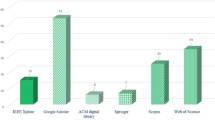Abstract
Web accessibility evaluation is a broad field that combines different disciplines and skills. It encompasses technical aspects such as the assessment of conformance to standards and guidelines, as well as non-technical aspects such as the involvement of end-users during the evaluation process. Since Web accessibility is a qualitative and experiential measure rather than a quantitative and concrete property, the evaluation approaches need to include different techniques and maintain flexibility and adaptability toward different situations. At the same time, evaluation approaches need to be robust and reliable so that they can be effective. This chapter explores some of the techniques and strategies to evaluate the accessibility of Web content for people with disabilities. It highlights some of the common approaches to carry out and manage evaluation processes rather than list out individual steps for evaluating Web content. This chapter also provides an outlook to some of the future directions in which the field seems to be heading, and outlines some opportunities for research and development.
Access this chapter
Tax calculation will be finalised at checkout
Purchases are for personal use only
Similar content being viewed by others
References
Ash, L. (2003) The Web Testing Companion. Wiley Publishing, Indianapolis.
BIENE (2006) Barrierefreies Internet Eröffnet Neue Einsichten. German Web award organized by Aktion Mensch and Stiftung Digital Chancen, May 2006.
Black, R. (1999) Managing the Testing Process. Microsoft Press, Redmond.
Brajnik, G. (2004a) Comparing Accessibility Evaluation Tools. Springer-Verlag, Berlin.
Brajnik, G. (2004b) Using Automatic Tools in Accessibility and Usability Assurance Processes. Springer-Verlag, Berlin.
Brajnik, G.(2006) Web Accessibility Testing: When the Method is the Culprit. In proceedings of 10th International Conference on Computers Helping People with Special Needs (ICCHP), Linz.
Brajnik, G., Mulas, A., and Pitton, C. (2007a) Effects of sampling methods on web accessibility evaluations. In proceedings of ASSETS, Tempe.
Brajnik, G. (2007b) Ranking websites through prioritized web accessibility barriers. In proceedings of Technology and Persons with Disabilities Conference (CSUN), Los Angeles.
Bühler, C., Heck, H., Perlick, O., Nietzio, A., and Ulltveit-Moe, N., (2006) Interpreting Results from Large Scale Automatic Evaluation of Web Accessibility. In proceedings of 10th International Conference on Computers Helping People with Special Needs (ICCHP), Linz.
Chevalier, A. and Ivory, M. Y. (2003) Web site designs: Influences of designer’s experience and design constraints. International Journal of Human-Computer Studies, 58(1):57–87.
EIAO (2007) European Internet Accessibility Observatory. http://www.eiao.net.
Englefield, P., Paddison, C., Tibbits, M., and Damani, I. (2005) A proposed architecture for integrating accessibility test tools. IBM Systems Journal, 44(3), August 2005.
ISO (1995) Singh, R. (Ed.) Software Life Cycle Processes. ISO 12207, Washington.
Ivory, M. Y. (2003) Automated Web Site Evaluation. Kluwer, Dordrecht.
Henry, S. L. (2002) Web Accessibility Evaluation Tools Need People. Online resource by UI Access, located at http://www.uiaccess.com/evaltools.html, August 2002.
Henry, S. L. (2007) Just Ask: Integrating Accessibility Throughout Design. Lulu.com.
Mendes, E. and Mosely, N. (Eds., 2006), Web Engineering, Springer-Verlag, Berlin.
Nielsen, J. (1993) Usability Engineering. Academic Press, Cambridge MA.
Slatin, J. M. and Rush, S. (2003) Maximum Accessibility. Addison-Wesley, Boston.
Tatcher, J., Burks, M. R., Heilmann, C., Henry, S. L., Kirkpatrick, A., Lauke, P. H., Lawson, B., Regan, B., Rutter, R., Urban, M., and Waddell, C. D., (2006) Web Accessibility: Web Standards and Regulatory Compliance, Friends of Ed, Springer, New York.
Vigo, M., Arrue, M., Brajnik, G., Lomuscio, R., and Abascal, J. (2007) Quantitative metrics for measuring web accessibility. In proceedings of The 2007 International Cross-Disciplinary Workshop on Web accessibility (W4A), Banff.
WAB (2007) Velleman, E., Velasco, C. A., and Snaprud, M. (Eds.) Unified Web Evaluation Methodology (UWEM) 1.1. Online resource by WAB-Cluser, located at http://www.wabcluster.org/uwem1_1/, July 2007.
WAI (2005a) Abou-Zahra, S. (Ed.) Preliminary Review of Web Sites for Accessibility. Online resource by W3C Education and Outreach Working Group, located at http://www.w3.org/WAI/eval/preliminary.html, October 2005.
WAI (2005b) Abou-Zahra, S. (Ed.) Conformance Evaluation of Web Sites for Accessibility. Online resource by W3C Education and Outreach Working Group, located at http://www.w3.org/WAI/eval/conformance.html, October 2005.
WAI (2005c) Henry, S. L. (Ed.) Involving Users in Web Accessibility Evaluation. Online resource by W3C Education and Outreach Working Group, located at http://www.w3.org/WAI/eval/users.html, November 2005.
WAI (2006a) Abou-Zahra, S. (Ed.) Selecting Web Accessibility Evaluation Tools. Online resource by W3C Education and Outreach Working Group, located at http://www.w3.org/WAI/eval/selectingtools.html, March 2006.
WAI (2006b) Abou-Zahra, S. (Ed.) Web Accessibility Evaluation Tools. Online resource by W3C Education and Outreach Working Group, located at http://www.w3.org/WAI/ER/tools/, March 2006.
WAI (2006c) Brewer, J. (Ed.) Using Combined Expertise to Evaluate Web Accessibility. Online resource by W3C Education and Outreach Working Group, located at http://www.w3.org/WAI/eval/reviewteams.html, March 2006.
WAI (2007a) Henry, S. L. (Ed.) Web Content Accessibility Guidelines Overview. Online resource by W3C Education and Outreach, and W3C Web Content Accessibility Guidelines Working Groups, located at http://www.w3.org/WAI/intro/wcag.php, April 2007
WAI (2007b) Henry, S. L. and Abou-Zahra, S. (Eds.) Evaluation And Report Language. Online resource by W3C Education and Outreach, and W3C Evaluation and Repair Tools Working Groups, located at http://www.w3.org/WAI/intro/earl.php, March 2007
WebAIM (2006) WebAIM Accessibility Evaluation Framework. Online resource located at http://eval.webaim.org/, November 2006
Author information
Authors and Affiliations
Corresponding author
Editor information
Editors and Affiliations
Rights and permissions
Copyright information
© 2008 Springer-Verlag London Limited
About this chapter
Cite this chapter
Abou-Zahra, S. (2008). Web Accessibility Evaluation. In: Harper, S., Yesilada, Y. (eds) Web Accessibility. Human-Computer Interaction Series. Springer, London. https://doi.org/10.1007/978-1-84800-050-6_7
Download citation
DOI: https://doi.org/10.1007/978-1-84800-050-6_7
Publisher Name: Springer, London
Print ISBN: 978-1-84800-049-0
Online ISBN: 978-1-84800-050-6
eBook Packages: Computer ScienceComputer Science (R0)




